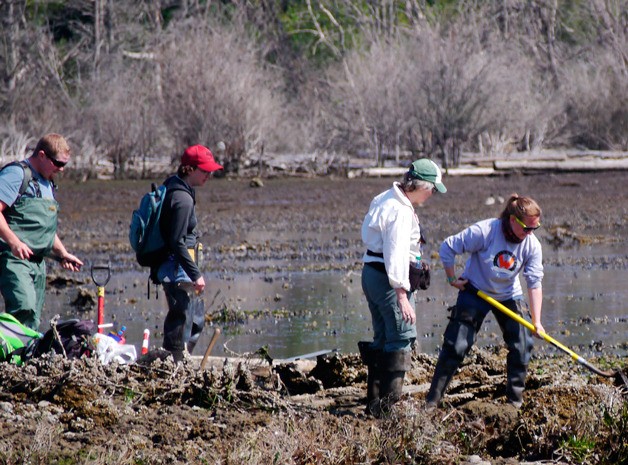Each year there are 317 earthquakes within 35 miles of Coupeville.
This factoid, offered by local oceanographer Jim Rich, shows the instability of Whidbey Island’s geologic makeup. While most of these earthquakes are too small to notice, if an event is large enough it could trigger local landslides and even tsunamis.
“The one thing you don’t want to do is overstate the threat,” Rich said. “You don’t want to understate it either. You want to hit it right on the head.”
Rich, a volunteer with the county’s Department of Emergency Management, presented this information to county commissioners this month as part of a push to research Whidbey Island’s history of tsunamis.
A team comprised of local scientists and volunteers, along with state and national experts, will be starting research in Crescent Harbor and Dugualla Bay July 8-17.
“This is big,” said Eric Brooks, deputy director of the Department of Emergency Management. “We hope it’s the first of many.”
Researchers from Central Washington University, University of Washington and the U.S. Geographical Survey will be visiting Oak Harbor during the July event to survey the areas and take samples from the land, marshes and beaches.
A 2004 study of the eastern Strait of Juan de Fuca, found extensive tsunami flooding in some areas as a result of a fault shift in the open ocean, according to Brandman University geology professor Ward Beebe.
In the Pacific Northwest, an open ocean tsunami will most likely be linked to the Cascadia Subduction Zone, an area the length of Washington and Oregon where the Juan de Fuca plate is pushing underneath the North American plate 100 miles off the West Coast.
The 2004 study showed that at some point in its geological history, a tsunami occurred and left the eastern strait deposits. In addition, other researchers have found tsunami deposits in Swantown Marsh, Beebe said.
However, there is still a lot to be discovered about the tsunami history within Puget Sound.
“There’s still a lot we don’t know about the geology of this area,” Beebe said.
While research has been done on the effects the Cascadia Subduction Zone could have on Western Washington, very little has been done specific to Whidbey Island until recently, according to Rich.
“There’s some good things to come out of this,” Rich said. “No one’s done any work here.”
Data from a geological symposium held on Whidbey last year shows that the island has four fault systems running through it.
The South Whidbey Fault system is comprised of three parallel faults running southwest through the width of the South End; the Darrington-Devil’s Mountain fault runs through the north tip of Whidbey; the Strawberry Point Fault runs across the thickest part of north Whidbey and branches out through Strawberry Point; and the Utsalady Point Fault runs southwest through Oak Harbor to the tip of Camano Island.
Rich said that these smaller fault systems can be triggered by larger earthquakes or shift all on their own. The effect can go completely unnoticed, as is common, or could potentially cause landslides or tsunamis between the islands.
“There’s a potential of tsunamis from faults within the Sound,” agreed Beebe. “But we’re not likely going to get the same effect. I would think they would be much smaller.”
The data collected in July should start to help researchers form a picture of Whidbey’s tsunami risk, and how to manage it, Rich said. Soil, sand and peat samples will be taken to an Accelerator Mass Spectrometry lab in Bothell for Carbon dating.
In addition to the academic researchers involved, Island County emergency management will partner with the Coupeville Lion’s Club, Whidbey Island Naval Air Station, the City of Oak Harbor, the Whidbey Camano Land Trust, Candlewood Suites and Boy Scout Troops 57 and 58.
However, Rich said, the group is still seeking additional funding and manpower to complete the research project.



